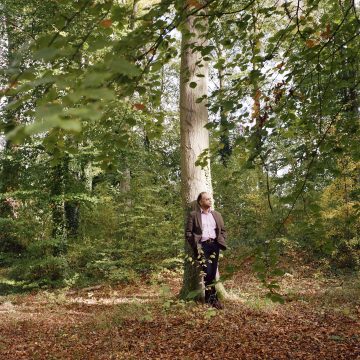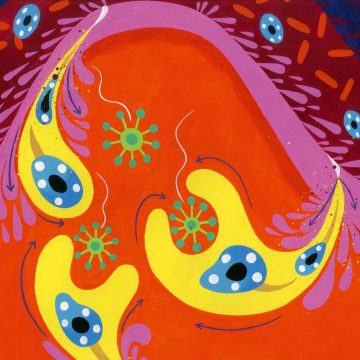On Boredom
Before the internet, boredom was something to be feared. Today, experts are wondering whether it might actually be good for us
Søren Kierkegaard thought it the root of all evil. Mary Renault considered it intellectual defeat. Jean Baudrillard declared it the world’s second worst crime. But where boredom might once have been something to fear, a state to be guarded against both in oneself and in others, today we are never truly bored. In our era of social media, smartphones and non-stop notifications, how can we be?
In fact, according to the University Computer Lab’s Device Analyser, most of us check our smartphones nine times – or more – a day. The most frequent users make 52 checks. That’s almost 19,000 times a year. “Those little spaces of ‘no work’, like walking through a park, are disappearing,” says Tom Hodgkinson (Jesus, 1986), founder of cult journal The Idler, which advocates a slower-paced approach to life. “You can now work while walking to work. By contrast, you have to make a special effort to create situations for idleness.”
“If you want to control things, you have to be patient. It’s a kind of control to stop and have deep thoughts. It’s countercultural”
Oliver Burkeman
But if, as thinkers of previous centuries believed, boredom is such a crime, why should we care? Psychology writer and Guardian journalist Oliver Burkeman (Christ’s, 1994) recently spent three hours standing in front of a painting, Edgar Degas’s Cotton Merchants in New Orleans. “I spent the first 45 minutes regretting the choice. It’s just three men in a room. There’s not enough going on. It’s claustrophobic. You feel jumpy at first. You feel like you’ve got to be doing something more productive. It gets harder and harder – and then, after a while, it’s not so difficult any more. The second hour is much harder than the third.”
Burkeman is not a masochist of a peculiarly artistic stripe. He was intrigued by the practise of a Harvard art history professor, Jennifer Roberts, who sends her students to stand in front of an artwork of their choosing – just one – for three hours. The goal, he explains, is to discover “whether, at the end of it, you’ve achieved insights that you wouldn’t in a shorter period of time”.
What Burkeman found was that he was discovering details in the painting that a cursory glance simply didn’t reveal: “Deliberate ambiguities. Shapes that echo other shapes. Aspects that seem almost like an optical illusion, when you give it your full attention.”
Faster, more impatient
Fascinating in itself, the experience also furnishes an excellent metaphor for what we can do, when we stop trying to do everything. “The reason that patience and stillness are so important right now,” says Burkeman, who is working on a new book about time, “is that the whole direction of culture is the opposite. You’d think we should be able to relax – we’ve got technology to do things and do them faster. But that is exactly nobody’s experience. The faster that technology drives us, the more impatient we are.”
Scientific understanding of what happens in our brain during periods when nothing – boredom – is happening has proved elusive. The technological breakthrough that enabled researchers to measure neural activity during such idle states only came in the early 1990s, in the form of functional magnetic resonance imaging (fMRI).
“The brain is operating at a high level even when we don’t give it anything to do.”
Dr Julieta Galante
Focusing on what the brain does when it’s not obviously ‘doing stuff’ – what’s known as the resting state – researchers identified a collection of brain regions called ‘the default mode network’ (DMN). It refers to areas of the brain in which researchers notice high levels of coordinated activity even when subjects are just lying inside the fMRI scanners doing nothing. Since then, it’s been popularly understood as a kind of ‘default mode of brain function’ – a state in which the brain is highly active in the background, but not carrying out any specific tasks.
What does that mean? Previous studies suggest the DMN plays a role in everything from consciousness and self-awareness (there is a marked reduction in its activity in vegetative-state patients), to cataloguing new information, to trying to project ourselves into the future by assessing past events. Dr Deniz Vatansever, lead author of a recent paper published in the Proceedings of the National Academy of Sciences from the University’s Department of Clinical Neurosciences, explains that working out exactly what the brain is up to in these periods of boredom is still as much speculation as fact. But everything points to the idea that during these idle states “we might be trying to make sense of the world around us by using what we already know about it”.
The default mode network
Which is why Vatansever and his Cambridge coauthors, Professor David Menon and Dr Emmanuel Stamatakis, carried out an experiment to pinpoint the exact functional role of the DMN in human cognition. Using fMRI, they observed subjects during two distinct phases of a card-matching game: first, when figuring out through trial and error the rules of the game; second, when applying those learned rules to achieve fast and effortless results.
“Things have been bad for 500 years now, and then got really bad in the past decade.”
Tom Hodgkinson
“In the learning stage, you get more engagement from the brain’s dorsal and frontoparietal attention networks,” says Vatansever. “We know these are associated with tasks that require a lot of attention and perceptual judgments. But we found that when you’re applying the learned rules from memory, you get more engagement from the default mode network regions.”
What Vatansever and the Cambridge team discovered refines this understanding of the DMN during states of rest. “The brain is operating at a high level even when we don’t give it anything to do. The extra activity when we give it a task is actually a much smaller increase than the processes carried out during idle states.” In other words boredom – a state of inactivity – seems to take as much effort as actively doing something. It is possible that far from being uninspiring and mechanistic, the part of the brain that the Cambridge team saw kick into action as their subjects switched from learning to applying the rules of the card game is central to many valuable behaviours – including ones that drive creativity. Boredom might actually be good for you.
And as neuroscience works to reveal the unexpected extent of DMN activity, researchers in related fields are focusing on real-world applications. “Neuroscientists describe the hard-wiring,” says Dr Julieta Galante, a research associate at the Department of Psychiatry. “But we don’t really have a handle on how that relates to patient health. Research on meditation shows the default mode network is used less, for example, but it’s hard to extrapolate what that means. Policymakers want to know ‘Is mindfulness training beneficial?’ not ‘Which part of the brain is doing what?’. So that’s what I try to measure.”
University counselling services were concerned that students, after presenting a lower prevalence of anxiety and depression than the wider population at the start of their first year, then accelerate to a higher incidence in their second year. So they decided to pilot mindfulness courses, and contacted Galante and her colleagues to conduct a randomised controlled study into whether these were effective.
The findings, reported recently in The Lancet, were striking. “The students who did mindfulness were significantly less distressed during exam time – and that was two to six months after finishing their training,” says Galante.
Socratic-Roman contemplation
‘Mindfulness’, as taught, covers a range of behaviours, from meditation techniques drawn from diverse traditions and cultures, to exercises derived from modern psychology, to the practise of ‘mindful eating’. What the students weren’t being taught was to do nothing.
“It’s the opposite of not doing anything,” Galante explains. “You’re never told: ‘Clear your minds, stop your thoughts.’ You’re taught to observe what happens, to be alert to physical sensation, sounds and images, but not to lose yourself in those sensations. Instead, to be aware that you are aware.” To experience, in other words, the itchy sensation of boredom – and go deeper into it, filling it with meaning.
As Hodgkinson points out, boredom is rarely an endpoint. “Idling is not doing nothing,” he says. “It is thinking. Reading. Sitting round and talking together. You could say the concept was invented by Socrates. The Romans called it the vita contemplativa, and there was much debate about which was better, the life of contemplation or the life of activity. Then, Protestant thinking was that contemplation was sinful.” “So, things have been bad for 500 years now,” jokes Hodgkinson, “and then got really bad in the past decade.”
During fieldwork in the Dadaab refugee camp in Kenya, Dr de la Chaux witnessed the enforced inactivity endured by many displaced persons – and their untapped entrepreneurialism
The original ‘Protestant work ethic’, much like our modern ‘always working’ culture, scorned the appearance of indolence. And, as we can all attest, there are certainly times when its censorious view of idleness – characterised by frustration and pointlessness – seems all too accurate. Yet even subscribing to this negative view of inactivity as mere aimless time-passing, an upside may still be found: the idea that periods of idleness enhance productivity during periods of activity. That original idler, Dr Johnson, was a prime example. He produced work in frenetic bursts, spurred by guilt about his protracted inactivity.
The notion of boredom fuelling productivity sparked a striking paper from Cambridge Judge Business School, authored by then-Gates scholar Marlen de la Chaux (Selwyn 2011). During fieldwork in the Dadaab refugee camp in Kenya, she witnessed the enforced inactivity endured by many displaced persons – and the untapped potential of their entrepreneurialism.
Productive inactivity
De la Chaux says that camp life imposes “immense boredom”. By contrast, when refugees are given the opportunity to establish microbusinesses (something not always encouraged, due to governmental fears about temporary settlements becoming permanent) it creates economic activity and helps people “to achieve a sense of purpose in their life and build an identity”. The ‘bad’ kind of boredom, without stimulus and not of our choosing, can ironically stir us to action.
So, from remarkably active inactivity when our brain’s default mode network is alight with processing power, to focused mindfulness that both stimulates and soothes, to downright boredom that drives us to heightened productivity, ‘just Doing Nothing’ – as Winnie-the-Pooh would have it – can take many enriching forms. Even the ultimate state of inactivity – barely conscious rest – contributes to our wellbeing, argues Burkeman. “There are straightforward benefits of rest, even if all you’re doing is recuperating. Even if you’re not growing in some way, or giving a new richness to your being, you’re still respecting the fact that we’re rhythmic creatures,” he says.
As society grows conspicuously more restless, there is increasing appreciation of the various modes of doing less. As attested to by the explosion of coffee shops, the expansion of the leisure industry, and even the opening of bespoke stores stocking only paper-printed magazines, we’re realising that – as Hodgkinson says – you’ve got to make an effort to do nothing.
In that, we’re occupying a unique historical moment. “In the past,” says Burkeman, “you had to put up with unrewarding life circumstances, such as being a servant or a woman in a patriarchal society. You were expected to be patient and accept your lot. But then the world speeds up. You no longer have to be patient because you can’t control things – it’s flipped so that if you want to control things, you have to be patient. It’s a kind of control to stop and have deep thoughts. It’s countercultural.”
So the next time you find yourself absentmindedly reaching for your phone or flicking through another 100 images on Instagram, stop. Let the scratchy feeling of boredom invade your brain. It could be one of the most rewarding – and rebellious – things you’ll do today.







